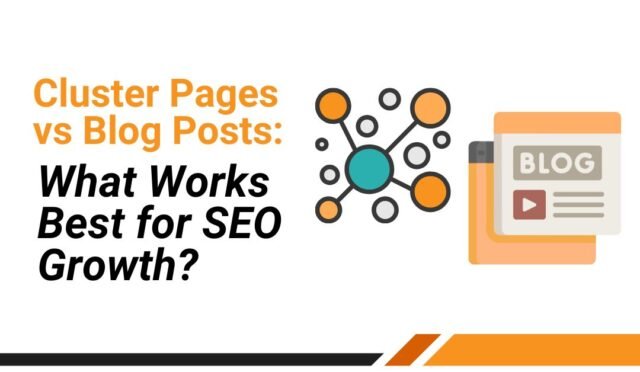Beginning
Think about a digital world that is always changing, where each piece of content has a specific purpose and is part of a broader theme. Content clustering can do this. You can make your business stand out by partnering with a digital marketing company in Chennai organizing the content on your website into creative clusters. This will give search engines a strong subject base. We’ll talk about what cluster pages and blog posts are, how they can help your SEO, and how to choose the best one or, even better, how to use both to boost your SEO over time.
What do the pages in a group stand for?
Cluster pages, which are also called “pillar pages,” are long, detailed posts that cover a wide range of topics. They are the most important part of a content cluster and connect to a lot of other related subtopics. A cluster page gives an overview of a topic and connects to blog articles or subpages that go into further detail about certain areas of it.
- Depth and breadth: Cluster pages show important concepts in a clear way.
- Structured Navigation: Internal links help people and search engines find more content.
- Building Authority: Cluster pages show that you know a lot about a subject and that it has something to do with your website.
What are the postings on a blog?
A blog post is a single entry about a certain subject, like a query, news, tutorial, case study, or opinion. They usually have between 700 and 1,500 words, however the number of words may change based on the topic and the demands of the audience.
- You can write on news, trends, or in-depth courses on certain topics.
- Engagement: A current, conversational tone makes readers want to talk and get involved.
- Linkability: It’s simpler to gain links when you respond to precise but useful requests.
The main differences between cluster pages and blog posts
| Part | Cluster Pages | Posts on the Blog |
| What it is | A general picture. | Narrow focus |
| Length | Long-form (more than 2,000 words) | Medium-length (700–1,500 words) |
| Goal | Hub for topic authority. Internal linking could give you specialized information or a way to become involved. | A lot of information, with links to subtopics. Links to postings or other resources that are useful. |
| SEO Effect | Overall Knowledge | Targets questions with long tails |
Why do cluster pages help with SEO growth?
More authority on the subject
Cluster pages show search engines that your site is an expert on a certain topic by putting together relevant information. This structure helps algorithms figure out which information is more important, which raises the rankings of both the pillar and its cluster content.
Better crawling
Search engine crawlers can identify and index all the pages in a cluster more readily when the links between them are strong. A strong internal link network makes sure that all of your content is seen and gives ranking power to different pages.
Time Spent and User Experience
Visitors like things that are structured well. When someone visits a full pillar page, they can look through the subtopics that interest them. This keeps visitors on your site longer, shows search engines that they are interested, and lowers bounce rates.
Content that can grow
As you learn more, you can add more subtopics to a cluster that already exists. This flexible method lets your website change over time while keeping its main idea.
Benefits of Blog Posts for SEO Growth
Focusing on Long-Tail Keywords
Blog entries are great for getting people to ask specialized, low-volume inquiries. Answering specific user questions, such “how to optimize meta descriptions,” may draw attention to specialty inquiries that cluster sites may not be able to fully answer.
Trends and Newness
Adding new blog posts on a regular basis keeps your site up to date. Search results are more likely to show websites that have new information. Posts that talk about current trends that are on the rise can quickly get backlinks and social shares.
Sharing and Getting Involved
Readers are more likely to leave comments, share on social media, and subscribe to blogs that are easy to read and sound like a discussion. This link helps people remember your brand and makes it easier for them to connect with other people.
You can have several kinds of material
There are many various types of blog posts, like listicles, how-tos, case studies, and interviews. This form is appealing to a lot of people and can be utilized in bigger marketing campaigns.
Best Practices: How to Choose Between Blog Posts and Cluster Pages
Think about what you want to get done
A cluster page is a great way to get a lot of people to see your issue and help them learn a lot. Focus on blog posts for quick wins, regular updates, and finding the perfect keywords.
Results of Keyword Research
Find general, high-volume keywords for your main subjects and long-tail keywords for each blog article using tools. A good mix will make sure you show up for both competitive and niche searches.
Make a calendar for your content
First, make the cluster pages the base. Then, write blog posts that go into further detail about the subtopics while still connecting them to the core issue. This two-tiered structure gives the most power and reach.
Watch the performance stats
Keep an eye on your rankings, organic traffic, dwell time, and conversions. If your cluster pages aren’t getting the expected results for wide keywords, try adjusting the depth of the content or how the sites are linked together. If your blog posts aren’t getting a lot of traffic, you might want to rethink the keywords you’re using or include additional multimedia.
How to Get the Best Results by Combining the Two
Start with an audit of your material
Look for pages that are already there that can be used as cluster hubs or subtopics. Put together similar posts and make sure that old information is up to date.
Create Pillar Pages
Write tutorials on your main topics that are at least 2,000 words long. Headings, summary boxes, and a list of subjects will make it easier to find your way around.
Make a list of subtopics
Write a number of blog entries that answer different queries or problems that have to do with the pillar. There should be a natural link back to the cluster page and any relevant publications in each post.
Use the same internal links every time
Make sure your links make sense by going from page to blog post to similar blog posts. Use anchor text that tells the reader what the link is about and matches the keywords you want to rank for.
Make the parts of the page Better
Every page, whether it’s a pillar or a post, should have a unique title tag, meta description, and URL slug that tells people what the page is about. You can utilize schema markup for FAQs and how-tos when it’s acceptable.
Use it again and again
Share your blog posts on social media, via newsletters, and on forums. Make eBooks or slide shows out of cluster material that people may download to get more backlinks and leads.
How to Track Your Progress and Make Changes
- Check the ranks for both the primary topic and the subtopics. It’s easier to find relevant material when the ranks of pillar keywords go up.
- Analysis of Traffic
You can use Google Analytics to see how much organic traffic is increasing. You can make sure that your linking methods bring readers to the proper areas on your website by paying attention to referral pathways. - Metrics for Engagement
Page views per session, bounce rate, and time on page are all ways to measure engagement. A strong engagement rate means that your cluster structure makes sense to readers. - Rates of conversion
Check to see how many forms, downloads, and purchases cluster pages get compared to blog entries. We will be able to use our resources better in the future thanks to this information.
In the end
You don’t have to pick between cluster pages and blog posts. A clever mix combines the authoritative power of pillar content with the accuracy of targeted blog posts. By properly linking and optimizing both, you can create a content ecosystem that helps SEO thrive. No matter how big or small your business is, a clustered strategy lets you acquire both wide subject authority and more focused search alternatives. If you own a business and need help from experts, you might work with some of the best SEO companies in Chennai to build a content plan that meets your needs.







